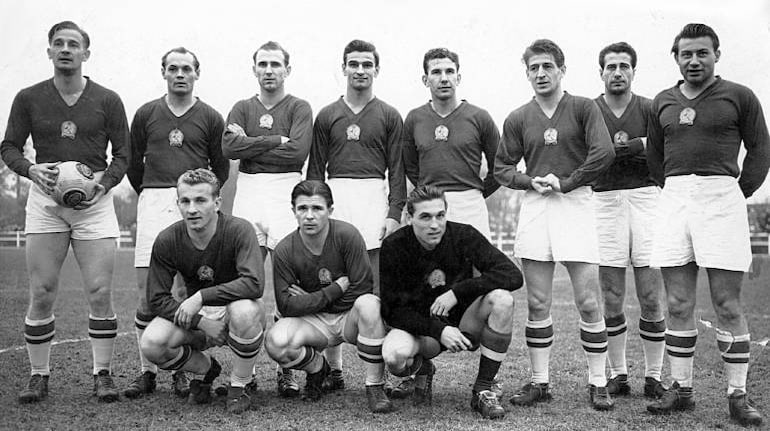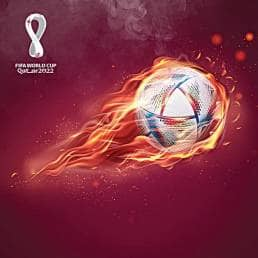



Were the Mighty Magyars – the Hungarians of the early 1950s – the greatest football team of all time? The World Football Elo Ratings certainly agree. Hungary’s Elo rating of 2230, on 30 June 1954, remains the highest in the history of international football. Barring Germany (2223 in 2014) and England (2216 in 1912), no other side has broken even the 2200-barrier.
 Read more FIFA 2022 stories here
Read more FIFA 2022 stories here
The Hungarians won the 1952 Olympic Games, the 1953 Central European International Cup. Between 1950 and 1956, they played 69 matches. Of these, they won 58, drew 10, and lost only one. This column is about the one defeat they suffered, in the 1954 FIFA World Cup final. As the numbers suggest, it was no less than a miracle.
The Golden Team
What made the team special? In Gusztáv Sebes, the Hungarian deputy Minister of Sports, they had a visionary manager who understood the importance of a proper fitness regime and training camps that replicated match situations; implemented strategic changes that helped the team switch seamlessly between attack and defence; and encouraged ‘total football’ before the Netherlands made it a phenomenon in the 1970s.
Of course, there were the superstars. ‘Golden Head’ Sándor Kocsis was among the deadliest when the ball was in the air, and finished with more goals than matches. Centre-forward Nándor Hidegkuti lay deep, a position key to Sebes’ innovative tactics: he acted as the feeder for the strikers, but could be devastating when he chose to invade.
Just behind Hidegkuti, to his left, would be the “fast, incisive” Zoltán Czibor; to his right, László Budai. There was József Bozsik, in Brian Glanville’s words, “a driving, attacking player, with strength, confidence and, of course, superb control; his side’s chief dynamo”.
In defence, lay the big, muscular, no-nonsense pair of Jenő Buzánszky and Mihály Lantos. Behind them all was ‘Black Panther’ Gyula Grosics, who, apart from his brilliant skills in the goal, would rush out to chip in as an extra defender.
But the biggest name of the side was ‘Galloping Major’ Ferenc Puskás, whose nickname was a combination of his style and army rank. The Encyclopaedia Britannica notes Puskás as the “sport’s first international superstar”. His control and skills were legendary, as was his ability to hoodwink defenders with ‘dummy’ dribbles. But most vicious was that left-footed kick that would find the target from far away.
Who would even dream of beating this boutique of stars?
Also read: The FIFA World Cup: Bizarre incidents, Part 1, 2, 3
The World Cup
The hype around Hungary was tremendous when they arrived in Switzerland. They had come with a run of 31 unbeaten matches. They had thrashed England 6-3 in Wembley – the first non-British team to win there – and 7-1 in the return match in Budapest.
At the World Cup, they predictably swept South Korea 9-0. Kocsis did the hat-trick and Puskás scored twice, but the most spectacular goal came from Lantos, who hit a thunderbolt of a free-kick through the Korean wall.
Next came West Germany, who had been admitted to FIFA only after the 1950 edition, and had hardly played international football ahead of the World Cup barring some friendly matches and the qualifier.
Yet, they were a reasonably strong unit, and had the advantage of having several men who played alongside each other at the FC Kaiserslautern. Centre-forward Ottmar Walter and right-half Horst Eckel were the biggest names, and as the tournament unfurled, inside-right Max Morlock and outside-right Helmut Rahn grew in stature. At the helm of everything was the much-respected captain, the inside-forward Fritz Walter.
Hungary won this match 8-3. Kocsis scored four of these goals. Two things happened in this match. First, German coach Sepp Herberger realised that it was prudent to assume a defeat against Hungary and focus on the must-win match against Turkey instead. So, he rested several first-choice footballers, and some played in unconventional positions. As a result, the Hungarians never faced a full-strength German side.
During the match, Werner Liebrich tackled Puskás hard. The great man endured a hairline fracture in his ankle and missed the quarter- and semi-finals. Hungary still beat Brazil in a violent quarter-final, a match remembered as the Battle of Bern, and Uruguay in the semi-final, both by 4-2 margins.
The unstoppable Kocsis scored twice in each of these two knockout matches. From four matches, Hungary had scored 25 goals, of which Kocsis had 11. With Puskás recovering to join Kocsis, they were one match away from having their hand on the coveted trophy.
There had been the odd hiccup. They missed the connecting bus from Lausanne to Bern and had to travel late at night, and their sleep was disturbed by a local fair. But the Hungarians were too great a side, and were in such great form that they were unlikely to be bothered.
Meanwhile, the Germans had brushed aside the 3-8 decimation by Hungary. They beat Turkey 7-2, Yugoslavia 2-0, and Austria 6-1 to meet the Hungarians again amidst heavy rain.
Also read: The FIFA World Cup: Controversies and moments, Part 1, 2, 3, 4, 5
The match
Puskás eventually played, putting all speculations to rest. He was almost certainly not fully fit, and substitutions had not yet been introduced. It was one of Hungary’s two dubious selectorial decisions of the day; the other was leaving out the in-form Budai.
Yet, things seemed to take a natural course when Puskás scored in the sixth minute. In the eighth, Czibor made it 2-0 after a back-pass from German defender Werner Kohlmeyer slipped off goalkeeper Toni Turek’s grip.
The Hungarians seemed to be all over the Germans – but then, Germany scored. Rahn’s cross found Morlock in the 10th minute, and Morlock scored. Then the Germans found a corner, then a second, and a third – and Rahn scored to equalise.
After 18 minutes, the scoreline read 2-2. Befitting of a World Cup that still holds the record for most goals per match (5.38).
The Hungarians kept attacking, but the German defence stood resolute. Even if the defence was breached, they were hitting the post, the bar. And when they hit on target, Turek, a man possessed, was saving everything. The Germans found some footing towards the end of the first half, but Hungary dominated again after the interval.
Hungary continued to dominate, but towards the end, the Germans counterattacked. Finally, in the 84th minute, German forward Hans Schäfer’s cross landed into the penalty box. Lontas failed to take control, and seizing the opportunity, Rahn scored his second goal of the match.
The Hungarians retaliated. Mihály Tóth sent a beautiful pass, past German defender Josef Posipal. Puskás’ ankle had slowed him down by now, but he still found the goal. English referee William Ling even allowed it, before having a word with ‘Sandy’ Griffiths, the Welsh linesman.
Ling then ruled Puskás offside and disallowed the goal. The decision is debated till date.
Hungary still almost equalised when Czibor had a shot on target – their 16th, compared to 10 by the Germans – but Turek saved this too.
West Germany won 3-2 to become the third team to win the FIFA World Cup. Hungary are yet to reach the final since then.
Also read: The FIFA World Cup: Facts, trivia, and anecdotes
Aftermath
The Hungarian fans went into mourning after the defeat. Thousands marched on to the streets of Budapest to protest against the regime. Gyula Grosics, the goalkeeper, theorised that “the seeds of the 1956 uprising” lay in these protests.
The Germans, ravaged by the second World War, looked at the triumph as a moment of uninhibited national pride. German historian Joachim Fest wrote that “it was a kind of liberation for the Germans from all the things that weighed down upon them after the Second World War.”
Franz Beckenbauer echoed Fest’s thoughts: “Suddenly Germany was somebody again. For anybody who grew up in the misery of the post-war years, Bern was an extraordinary inspiration. The entire country regained its self-esteem.”
This is part 2 of the FIFA World Cup classic series. Also read: FIFA World Cup classics, part 1: Maracanaço and the Phantom of 1950
Discover the latest Business News, Sensex, and Nifty updates. Obtain Personal Finance insights, tax queries, and expert opinions on Moneycontrol or download the Moneycontrol App to stay updated!
Find the best of Al News in one place, specially curated for you every weekend.
Stay on top of the latest tech trends and biggest startup news.